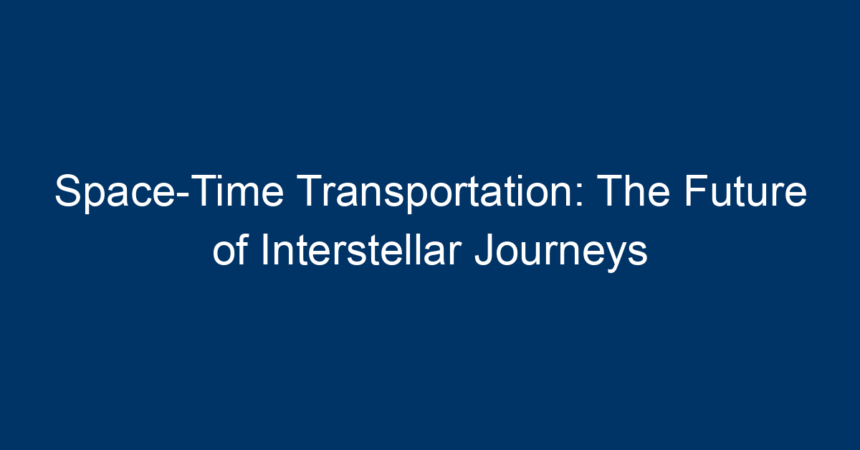Introduction
As humanity stands on the brink of stellar exploration, the concept of space-time transportation has captured the imagination of scientists, futurists, and dreamers alike. This revolutionary mode of travel promises to transcend our conventional understanding of time and space, potentially transforming how we journey through the cosmos. While interstellar travel has long been relegated to the realm of science fiction, advances in physics and technology are nudging this dream closer to reality. In this article, we will explore the principles behind space-time transportation, current theoretical frameworks, the implications for human exploration, and what the future may hold for interstellar journeys.
Understanding Space-Time Transportation
The Basics of Space-Time
To grasp the concept of space-time transportation, it’s essential to understand the framework of space-time itself. Developed by Albert Einstein, this four-dimensional construct fuses space and time into a single continuum. It posits that time is not an absolute phenomenon but is influenced by velocity and gravity. This understanding leads us to envision travel that not only bridges vast distances in space but also rethinks the importance of time in our journeys.
The Role of Wormholes
One of the most exciting theoretical concepts related to space-time transportation is the idea of wormholes. These hypothetical passages through space-time could create shortcuts between distant points in the universe. Imagine being able to step through a tunnel and instantly find yourself light-years away! Although wormholes have yet to be proven or observed, their mathematical grounding offers intriguing possibilities for future exploration.
The Alcubierre Drive: A Leap Forward
The Alcubierre Drive is another fascinating concept rooted in space-time transportation. Proposed by physicist Miguel Alcubierre in 1994, this theory suggests that a spacecraft could achieve faster-than-light travel by warping the fabric of space-time. Instead of moving through space, the spaceship would essentially ride a wave of warped space, contracting space in front of it while expanding it behind, enabling rapid interstellar travel. While this theory faces significant challenges concerning energy requirements and practical engineering, it sparks renewed hope for humanity’s aspirations to reach the stars.
Current Technological Advancements
Breakthroughs in Propulsion Technology
As researchers advance our understanding of physics, momentum is gaining in the realm of propulsion technologies. Innovations like ion propulsion systems and solar sails signify a shift away from traditional chemical rockets. While these technologies are primarily focused on extending our reach within the solar system, they lay the groundwork for future advancements in space-time transportation.
Quantum Mechanics and Teleportation
Quantum mechanics may also play a pivotal role in the future of space-time transportation. Concepts like quantum entanglement and teleportation, while still nascent and primarily theoretical, inspire the notion that particles can be transported across distances instantaneously. Though far from practical application in human travel, understanding these principles may hold the key to future advancements.
AI and Autonomous Spacecraft
Artificial intelligence (AI) is revolutionizing spacecraft design and navigation. Autonomous systems can enhance our ability to explore and gather data in deep space. By integrating AI with potential space-time transportation technologies, we could see more efficient missions and safer voyages into the unknown.
The Implications for Human Exploration
Colonization of Other Worlds
If space-time transportation becomes a reality, humanity might consider the colonization of distant planets and moons. The ability to traverse vast distances in minimal time would open up previously inaccessible regions of the universe for habitation and exploration. Imagine humanity settling on exoplanets, creating new societies, and exploring the rich diversity of the universe.
Cultural Exchange and Understanding
The advent of space-time transportation could usher in profound cultural exchanges between humanity and possible extraterrestrial civilizations. With the capacity to traverse the cosmos, we could gain insights into alien cultures, philosophies, and technologies—leading to a deeper understanding of our place in the universe.
Ethical Considerations
With great power comes great responsibility. The potential for space-time transportation raises ethical and philosophical questions. As we consider expanding our reach into the cosmos, how do we ensure the preservation of alien ecosystems? How do we navigate the implications of potentially encountering intelligent life? Addressing these ethical dilemmas will be vital as we progress toward interstellar travel.
Challenges and Limitations
Energy Requirements
One of the most significant challenges in realizing space-time transportation remains energy consumption. The ideas surrounding wormholes and the Alcubierre Drive involve staggering amounts of energy, far beyond our current capabilities. Researchers are exploring alternative energy sources, such as dark energy or antimatter, but these ideas are still hypothetical.
Physics Limitations
Understanding the universe’s fundamental laws is essential for developing viable space-time transportation technologies. While theoretical physics continues to evolve, we are still grappling with unresolved debates such as the true nature of black holes and the fabric of space-time itself. Further research will be necessary to advance our understanding and create practical applications of these theories.
Technological Roadblocks
Finally, there are technological challenges to be addressed. The materials required to construct a functioning Alcubierre Drive, for instance, remain speculative at best. Advances in material science and engineering are crucial for overcoming the practical issues that will accompany the development of these cutting-edge technologies.
Future Prospects for Space-Time Transportation
Research and Development
Investment in research and development is essential for transforming theoretical concepts of space-time transportation into reality. Government agencies like NASA and private corporations are increasingly funding projects focused on interstellar travel, encouraging collaboration among scientists and engineers across various disciplines.
Public Interest and Engagement
As public interest in space exploration grows, support for innovative space-time transportation technologies intensifies. Engaging the next generation through education and outreach programs can inspire future physicists and engineers to contribute to this vital field.
International Collaboration
The complexity and scale of interstellar travel necessitate international collaboration. As we look to the stars, governments, institutions, and businesses must work together to achieve common goals in exploration and research.
Conclusion: Embracing the Future of Space-Time Transportation
The notion of space-time transportation embodies humanity’s ancient quest for exploration and discovery. While we stand on the threshold of understanding these complex theories, the dream of interstellar journeys becomes nearer. By focusing on advanced technologies, ethical considerations, and collaborative efforts, we can make significant strides toward unlocking the universe’s mysteries.
As we embark on this exciting journey into the future, know that your interest and passion for space exploration play a pivotal role. Stay informed, engage with your community, and contribute to the global conversation about our future among the stars. Together, we can turn the vision of space-time transportation into a reality, paving the way for the next chapter in human exploration.




